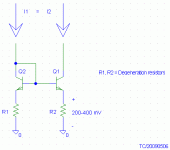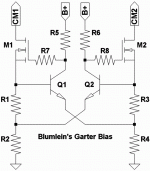Balancing current in PP amplifiers. What do you think?
An externally hosted image should be here but it was not working when we last tested it.
Great use of a Thermaltrak!
Same, same but different :
:
http://www.diyaudio.com/forums/showthread.php?postid=1613405#post1613405
For a "normal" PP I would substitute the cathode resistor(above the diode) with a CCS as to make both tubes having CCSs at their cathodes.
Also Audiodesignguide has something alike at his site.
Same, same but different
http://www.diyaudio.com/forums/showthread.php?postid=1613405#post1613405
For a "normal" PP I would substitute the cathode resistor(above the diode) with a CCS as to make both tubes having CCSs at their cathodes.
Also Audiodesignguide has something alike at his site.
This assumes ideal (matched) output tubes that don't 'age' differently through use ?
No, the rightmost tube(slave) will get the same current as the left(master). This due to the currentmirror configuration.
No, it just balances current between the two. Could be used for class A or AB.Does this keep them in strict class A?
For a "normal" PP I would substitute the cathode resistor(above the diode) with a CCS as to make both tubes having CCSs at their cathodes.
Good idea. I just used a resistor so that it could be used for class AB also. Thanks for the link to the Septor schematic. Have you had good results with the current mirror? I'd think it provides good DC balance regardless of signal amplitude. Opposed to using trimmer methods, which will only balance DC at idle.
But the transistor current is not automatically the same as the diode current. They will track, but you need something more to make sure they are the same.
A resistor will be added to the diodes cathode and the BJT's emitter.
I am fairly sure the thermaltrak diode is NOT the same as the bipolar's emitter. And I'm not sure why it was done that way.
You may be right. I ordered the parts to give it a go. I'll provide some data when done.
revintage said:For a "normal" PP I would substitute the cathode resistor(above the diode) with a CCS as to make both tubes having CCSs at their cathodes.
Why is this with thermaltrak better than just a CCS under each cathode (not a rhetorical question)?
Sheldon
In order for the two currents to track, the diode will need to match the Vbe junction of the NPN. This is easily done by using a matched pair of NPN's and wiring one as a diode by shorting the Vcb junction. This is what's done in a standard current mirror.
One could also use a Wilson current mirror.
Generally, if the transistors are from the same batch they will match closely enough for practical purposes. If you want tighter matching, buy 10x what you need and match them with a curve tracer. If you go through all the trouble of matching the transistors, keep in mind that they will need to be thermally coupled and the layout parasitics should ideally be identical for all the transistors.
One could also just make the circuit less dependent on Vbe matching by inserting a degeneration resistor in the emitters of the two NPN's. If the voltage drop across the resistor is significantly larger than the Vbe mismatch, the matching will depend more on the matching between the resistors (keep them close together, oriented the same way, away from heat sources, etc) than on the Vbe matching. For precision IC design, I generally go with 200-400 mV of drop across the resistors. If you don't care about the last mV of headroom (which you most likely don't for tube amps), you could drop a volt or two and achieve excellent matching...
~Tom
One could also use a Wilson current mirror.
Generally, if the transistors are from the same batch they will match closely enough for practical purposes. If you want tighter matching, buy 10x what you need and match them with a curve tracer. If you go through all the trouble of matching the transistors, keep in mind that they will need to be thermally coupled and the layout parasitics should ideally be identical for all the transistors.
One could also just make the circuit less dependent on Vbe matching by inserting a degeneration resistor in the emitters of the two NPN's. If the voltage drop across the resistor is significantly larger than the Vbe mismatch, the matching will depend more on the matching between the resistors (keep them close together, oriented the same way, away from heat sources, etc) than on the Vbe matching. For precision IC design, I generally go with 200-400 mV of drop across the resistors. If you don't care about the last mV of headroom (which you most likely don't for tube amps), you could drop a volt or two and achieve excellent matching...
~Tom
Attachments
Tomchr,
Thanks for the suggestions. I'm aware of the typical current mirror (2 devices, 1 shorted base-collector). I was just thinking, if the internal diode of the thermaltrack transistor is a close match to the B-E junction of the BJT portion. It would be cool to have an all in 1 package mirror. Would eliminate a component and give maximum thermal coupling between each half of the mirror.
Your right. 1V drop across some degeneration resistors would be no problem for this application.
Thanks for the suggestions. I'm aware of the typical current mirror (2 devices, 1 shorted base-collector). I was just thinking, if the internal diode of the thermaltrack transistor is a close match to the B-E junction of the BJT portion. It would be cool to have an all in 1 package mirror. Would eliminate a component and give maximum thermal coupling between each half of the mirror.
Your right. 1V drop across some degeneration resistors would be no problem for this application.
Oh... It just dawned on me that the diode and the transistor are in the same package. Neat. At least then they'd be very close to the same junction temperature (unless you burn a whole bunch of power in one device and not in the other). While it is indicated as a diode on the schematic, I bet it's actually an NPN with the collector and base shorted. The two devices could potentially match very well.I'm aware of the typical current mirror (2 devices, 1 shorted base-collector). I was just thinking, if the internal diode of the thermaltrack transistor is a close match to the B-E junction of the BJT portion. It would be cool to have an all in 1 package mirror.
What's the part number for that Thermaltrack device?
I'm curious to hear what you find out as far as functionality and performance goes.
Thanks,
~Tom
What's the part number for that Thermaltrack device?
There is actually quite a few. On Semi makes them, if you google "thermaltrak" it will turn up some stuff. They were designed for output stage of solid state amplifier + tracking diode for the bias. I figured since the biasing resistors in tube output stages dissipate a fair amount of power, these transistor may work as a mirror (assuming that the diode matches the B-E portion of the BJT).
I'm looking at the NJL0281D from On Semi. I find it "interesting" that they make a bunch of claims about thermal tracking but don't specify any of it. All they show for the diode characteristics is the forward and reverse current vs voltage.
Anyway... Good luck with it. I'm curious to hear of your findings.
~Tom
Anyway... Good luck with it. I'm curious to hear of your findings.
~Tom
Jeb-D. said:
There is actually quite a few. On Semi makes them, if you google "thermaltrak" it will turn up some stuff. They were designed for output stage of solid state amplifier + tracking diode for the bias. I figured since the biasing resistors in tube output stages dissipate a fair amount of power, these transistor may work as a mirror (assuming that the diode matches the B-E portion of the BJT).
You can add a trimmer, with a center to ground, connecting a diode and an emitter to it's ends. Such a way you can balance current reflected from the left tube to the right one.
http://www.analog.com/en/other/matched-transistors/products/index.html
Though these are possibly too low power for direct use
in line with cathode currents, would work fine as VBE
voltage references and comparator/drivers for Alephs.
I doubt any pair of Blumlein'd Alephs really needs this
level of physical transistor matching to get darn close.
I been plannin to abuse old germaniums to achieve
an even lower dropout. Nothing needs match but VBE.
Matched current sources that work down to less than
a Volt on each drain. (You still need a 12 volts pull-up
from somewhere else for driving the gates)
Ye olde National LM194 also comes to mind....
Though these are possibly too low power for direct use
in line with cathode currents, would work fine as VBE
voltage references and comparator/drivers for Alephs.
I doubt any pair of Blumlein'd Alephs really needs this
level of physical transistor matching to get darn close.
I been plannin to abuse old germaniums to achieve
an even lower dropout. Nothing needs match but VBE.
Matched current sources that work down to less than
a Volt on each drain. (You still need a 12 volts pull-up
from somewhere else for driving the gates)
Ye olde National LM194 also comes to mind....
- Status
- This old topic is closed. If you want to reopen this topic, contact a moderator using the "Report Post" button.
- Home
- Amplifiers
- Tubes / Valves
- ThermalTrak transistor application.

